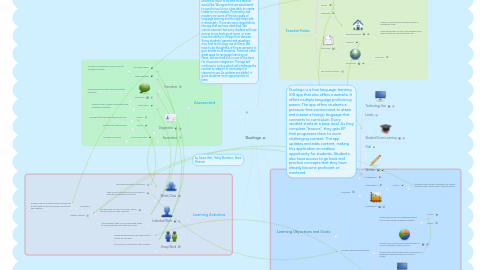
1. Learning Activities
1.1. Whole Class
1.1.1. Discuss the benefits of Duolingo
1.1.2. Make a goal for the amount of time used on Duolingo for the whole classroom
1.2. Individual Work
1.2.1. Set daily goals for amount of time used on Duolingo outside of the classroom
1.2.1.1. Homework
1.2.1.1.1. Teachers can set a certain amount of time the student needs to be on Duolingo and monitor their progress
1.2.1.2. Student Interest
1.2.2. Have students make a list of challenging words to discuss with the class after their lesson
1.3. Group Work
1.3.1. Create questions based upon the content learned on Duolingo
1.3.2. Let students collaborate on their answers
2. by Alexis Hart, Haley Bordelon, Brent Pearson
3. Assessment
3.1. Formative
3.1.1. Self Assessments
3.1.1.1. Duolingo self assesses on every level the students complete.
3.1.2. White Boarding
3.1.3. Disscusion
3.1.3.1. The application assesses verbal and written discussion.
3.1.4. Observation
3.1.4.1. Duolingo offers constant observation and feedback to students.
3.2. Diagonistic
3.2.1. Pretest
3.2.1.1. Duolingo starts everyone at the same level.
3.2.2. Survey
3.2.2.1. Duolingo can track progress
3.3. Summative
3.3.1. End of Unit Exams
3.3.1.1. Duolingo as an Exam
4. Our Take: As a group, we see the Duolingo app is an awesome way to get students involved driving their own learning. The application isn't a replacement for the foreign language teacher. This is an activity tool that can be utilized as much or as little as a teacher would like. We agree that we would want to use this tool in our class daily to create habits for our student. Proficiency and mastery are some of the key goals of language learning and this app helps with it immensely. There are some downfalls to the app that we have identified. We cannot assume that every student will have access to technology at home, or even have the ability to charge their devices. Some students' parents and guardians may limit technology use at home. We have to be thoughtful of this as we want to give access to all students. There are other great apps for language learning out there, but we think this is one of the best for classroom integration. The app will continue to evolve which will challenge the teacher to adapt it in more ways for classroom use. As updates are added, it gives students more opportunities to learn.
5. Learning Objectives and Goals
5.1. Standards
5.1.1. Engagement
5.1.2. Interpretation
5.1.2.1. Culture
5.1.2.1.1. Duolingo offers multiple categories for cultural discovery that is applicable to student interest.
5.1.3. Presentation
5.2. Example Learning Achievements
5.2.1. Students will be able to distinguish multiple topics in the foreign language (Spanish)
5.2.1.1. Culture
5.2.1.2. History
5.2.2. Students will be able to formulate thoughts on specific language content sections
5.2.3. Students will critically think about how different languages shape relations and cultures in society
5.2.4. Students will analyze different languages
5.2.5. Students will be able to create their own study guides and assessments
6. Teacher Roles
6.1. Administrator
6.2. Monitor
6.3. Mentor
6.4. Teammate
6.5. Messenger
6.5.1. Parent/Guardians
6.5.1.1. Parents can also be given progress report or individually check.
6.5.1.2. Parents/guardians can learn the language along with their kids by downloading the app.
6.5.2. Students
6.5.3. Community
6.5.3.1. Field Trips

